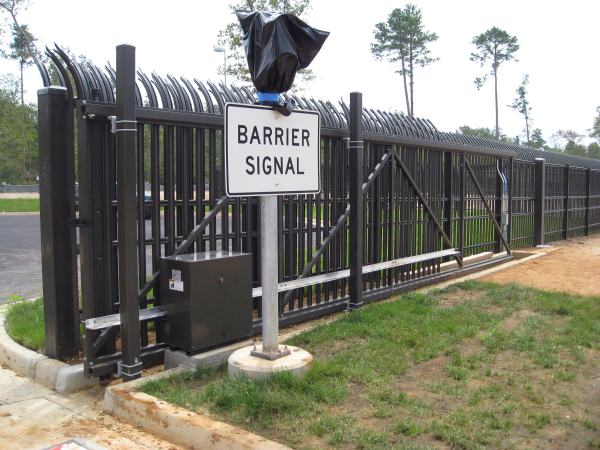
Security is one of the chief concerns for the data centers that are going up around the country. Data centers house telecommunication systems, data storage systems and computer systems. In order to protect these building and the information they store, companies are investing in crash rated (ATFP) perimeter security systems.
These perimeter security solutions are made up of several different types of barrier systems. Together, these high-security systems achieve a crash rating of K4, K8, or K12. This measure depends upon the amount of force the fencing or gate system can withstand and still remain intact.
A ‘K' rating is a Crash Test Certification issued by the Department of State (DOS) to a fence, gate, barrier or bollard indicating the perpendicular impact penetration of a vehicle of a specific weight at a specific speed. In other words, it measures the particular stopping power of a barrier in relation to the speed and weight of an incoming vehicle. The K-rating weight of the vehicle is standard at 15,000 lbs. These DOS standard barriers only allow the truck to penetrate no more than 36 inches past the bed.
- K4 rating is for a vehicle traveling 30mph
- K8 rating is for a vehicle traveling 40mph
- K12 rating is for a vehicle traveling 50mph
K rated gates are constructed of the same style of materials as the fenc e. High security operators automate these gates and they can either be opened with cards, codes, or manually by guards. These superior entry systems are usually enhanced with extra barrier systems for even more security. Examples of these are wedge barriers and tire deflation (TDD) devises. These allow instant entry and then immediately re-barricade the area. The gates are then animated by operating systems that have fully enclosed motors. A favorite operator for data center gates is HySecurity Slide Driver systems. These hydraulic engines have few moving parts, are highly reliable and last decades, even with constant use.
e. High security operators automate these gates and they can either be opened with cards, codes, or manually by guards. These superior entry systems are usually enhanced with extra barrier systems for even more security. Examples of these are wedge barriers and tire deflation (TDD) devises. These allow instant entry and then immediately re-barricade the area. The gates are then animated by operating systems that have fully enclosed motors. A favorite operator for data center gates is HySecurity Slide Driver systems. These hydraulic engines have few moving parts, are highly reliable and last decades, even with constant use.
In addition to crash-rated fence and gate systems, data centers are also using various combinations of natural and man made barriers to maintain security. Bollards, boulders, and jersey walls are often used in conjunction with high security fence systems to these ATFP compliant sites.
Bollards are short, vertical posts used to protect potentially vulnerable structures or objects from damage by moving vehicles. There are many types of bollards that include pop-up bollards, removable bollards, and cable reinforced bollards. Designed for versatility, these security posts range in size from 24†to 42†in height, and come in variable diameters to meet a location’s specific security requirements. The boulders that are being used for security purposes are usually 3’ x 5’ and spaced at regular intervals, as not to let a vehicle pass. Jersey walls can be used to form a maze for vehicles to maneuver. This again reduces speed and adds security to a center.
As our society continues to evolve and we become more dependent on technology, these data centers are invaluable and relevant to our continued economic and social success. These centers rely upon our current selections of security systems to safeguard their information and protect it from external attacks. The anti-terrorism force protection and crash-rated security systems will continue to develop new technologies and fence systems to better protect us. The demand for the best fence systems will continue to grow as global events unfold.
Article contributed by Meagan Stone.


